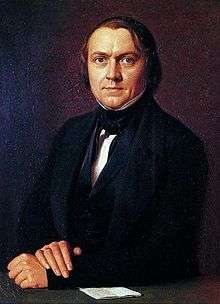Ditlev Gothard Monrad
| Ditlev Gothard Monrad | |
|---|---|
 | |
| Council President of Denmark | |
|
In office 31 December 1863 – 11 July 1864 | |
| Monarch | Christian IX |
| Preceded by | Carl Christian Hall |
| Succeeded by | Christian Albrecht Bluhme |
| Personal details | |
| Born |
24 November 1811 Copenhagen |
| Died |
28 March 1887 (aged 75) Nykøbing Falster |
| Political party | National Liberal Party |
Ditlev Gothard Monrad (24 November 1811 – 28 March 1887) was a Danish politician and bishop of Lolland–Falster.
Monrad's father, Otto Sommer Monrad, an attorney, suffered from mental illness, and spent some years in institutions; he died in 1863.[1]
Monrad studied theology and became a Lutheran minister, while beginning to participate in politics.[2] He became editor of the Liberal publication, Foedrelandet, in 1840, and was leader of the National Liberal Party and spearheaded the movement towards a constitutional Denmark after 1848, the year in which he became a bishop. In the following year, he became a member of Parliament and was Minister of Church Affairs in the new government.[3]
As Council President (1863-1864), he was the Danish state leader during the early part of Second Schleswig War, against the German Confederation led by Otto von Bismarck, which resulted in the Peace of Vienna.
After this war, a depressed and disillusioned Monrad emigrated to New Zealand. After sending his sons to Nelson and other districts of New Zealand to scout for land, he chose to settle in Palmerston North in the North Island of New Zealand. He bought 482 acres (1.95 km2) of land at Karere Block. He first lived in a small hut and then erected a timber house and started clearing bushland. He and his family farmed cows and sheep.
Monrad helped the New Zealand Company to find suitable settlers from Scandinavia and helped many Danish immigrants find land to settle on, most notably in the area of Dannevirke.
His work was disturbed by Māori rioters, members of the Hauhau cult under Chief Titokowaru. Monrad buried his belongings and went with the family to Wellington and then went back to Denmark in 1869. His sons Viggo and Johannes later returned to Karere to become farmers.
Before leaving New Zealand, he presented to New Zealand's Colonial Museum a collection of 600 woodcuts, etchings and engravings by European Old Masters, including Rembrandt, Hollar, Albrecht Dürer and van Dyck. They are now part of the collection at the Museum of New Zealand Te Papa Tongarewa where examples often feature in temporary exhibitions.
Monrad Intermediate is a Palmerston North intermediate school named after Monrad.
| Political offices | ||
|---|---|---|
| Preceded by New office |
Kultus Minister of Denmark 22 March 1848 – 15 November 1848 |
Succeeded by Johan Nicolai Madvig |
| Preceded by Carl Christian Hall |
Kultus Minister of Denmark 6 May 1859 – 2 December 1859 |
Succeeded by Vilhem August Borgen |
| Preceded by Vilhem August Borgen |
Kultus Minister of Denmark 24 February 1860 - 31 December 1863 |
Succeeded by Christian Thorning Engelstoft |
| Preceded by Johan Christian von Jessen |
Interior Minister of Denmark 24 February 1860 – 15 September 1861 |
Succeeded by Peter Martin Orla Lehmann |
| Preceded by Carl Christian Hall |
Council President of Denmark 31 December 1863 – 11 July 1864 |
Succeeded by Christian Albrecht Bluhme |
| Preceded by Carl Emil Fenger |
Finance Minister of Denmark 31 December 1863 – 11 July 1864 |
Succeeded by Christian Nathan David |
| Preceded by Carl Christian Hall |
Foreign Minister of Denmark 31 December 1863 – 8 January 1864 |
Succeeded by George Quaade |
| Preceded by Carl Christian Hall |
Minister for Holstein and Lauenburg 31 December 1863 – 11 July 1864 |
Succeeded by Christian Albrecht Bluhme |
Literature
- Johan Schioldann-Nielsen, The life of D.G. Monrad (1811-1887) : manic-depressive disorder and political leadership, Odense University Press, 1988. ISBN 87-7492-668-3.
- G.C. Petersen, D.G. Monrad : Scholar, statesman, priest and New Zealand pioneer and his New Zealand descendants, Kerslake, Billens & Humphrey. 1965.
References
- ↑ Johann Schioldann-Nielsen, "Prime Minister D. G. Monrad: manic-depressive disorder and political leadership", History of Psychiatry, March 1996 7: 063-90]. Accessed 15 February 2016
- ↑ Britannica. Accessed 2 June 2015
- ↑ Nicholas Hope, German and Scandinavian Protestantism 1700-1918. Clarendon Press, 1995. p 469. Accessed 15 February 2016
External links
- 50 Ministers of Education - From the Danish Ministry of Education.
- The Monrad Collection at the Museum of New Zealand Te Papa Tongarewa
- A biography
- Biography in 1966 Encyclopaedia of New Zealand
